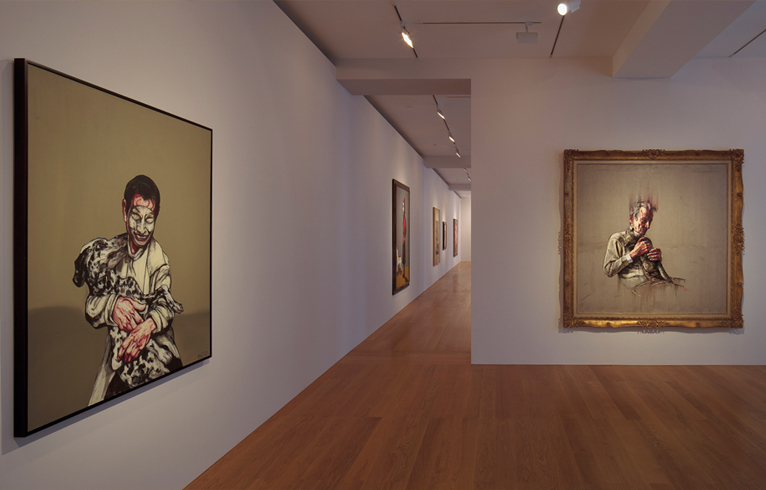ZENG FANZHI
| February 9, 2012 | Post In LEAP 12

Following on Zeng Fanzhi’s major exhibition of sculptures and mural-sized paintings at the Rockbund Art Museum in Shanghai last year (see review, LEAP 6), this tightly curated show at Gagosian’s Hong Kong space— the first there dedicated to a Chinese artist— possessed all the air of a retrospective.
Collating Zeng Fanzhi’s “wide-ranging depictions of the human figure in key paintings from the last twenty years,” the show chronologically arranges his output from 1989 to the present, with seven canvases dated between 1989 and 1994, and eleven between 2001 and 2011. At the entrance one is greeted imposingly by the artist himself in Artist Series Self-Portait (2011), suited in deep hues of blue and red against a solid background of gray and black. Here— but not for the first time— Zeng has granted himself his trademark oversized hands and eyes, the former clasped together sternly in front of his body, the latter gazing back into the gallery space, as if to ask what the viewer is waiting for; there are masterpieces expecting you behind.
At the very back of the gallery is Hospital Triptych No. 1 (1990), inaugural instances of Zeng’s bulging, bug-eyed figures in a narrow waiting room, in a dubiously aseptic operating theater, and on pews of sickbeds. Inspired by clandestine visits to a Wuhan hospital (with the assistance of a relative, he was able to masquerade as a doctor throughout the facilities) for his graduation portfolio at the Hubei Academy of Fine Arts, these crowded, mutated visions of Chinese society are clear precursors to the palettes of Zeng’s “Meat” series— from which the two paintings Meat (1993) and Man and Meat (1993) hang nearby— and the thick strokes of blood-red pigment that render human skin indistinguishable from the flesh of dead animals. In the same rear section of the space are Haircut (1989) and A Man in Melancholy (1990), two somber scenes that act out a student’s definition of metaphysical experience: visiting the barber, sitting in a chair. Distant from the hammer prices of the future, the two works are refreshing in that they speak not loudly of society’s faults, but quietly of the truths of loneliness.
Moving past the half-dozen other “key paintings” in the mid-section of the gallery it begins to seem that this exhibition serves but two functions: one, as a brief summation of Zeng Fanzhi’s past work, and two, as an unveiling of his current offerings. The latter portion dates to 2008 and nods strongly to Francis Bacon, starting with Bacon and Meat, a portrait of Francis Bacon in a trench coat holding up a slab of butchered pig. Another representation of the psychological figurative painter is transported out of blackness by Zeng’s whirling strokes in Bacon (2010), preceding Artist Series Pablo Picasso (2011) and the poignant, showstealing Artist Series Lucian Freud (2011), both assembling their eponymous subjects in a raw semblance of madness, emerging from the flat, solid canvas as if zooming out of a lucid dream. Picasso is young and aloof, again amidst whirls, and Freud, aged and glassy-eyed, cradling a fox in his arms: an allusion to Zeng’s socially critical pets of the mid-1990s, which symbolized power for their subject-owners.
One master recreates another, nods to his forces. This is the game of the great painters— to connect the dots along Art’s cosmic latitude— but it is still a game, and here it supplements the two apparent functions of the show with a third: from this altitude, juxtaposing the art-historic referential “Artist Series” works with Zeng’s earliest work is to proselytize the righteousness of that earliest work, to squeeze in that much more room for him in the canon of contemporary grandeur. In the end, leaving the pristine confines of the Gagosian Hong Kong cube northbound for Beijing, we have but one question: whom from our capital will these white walls behold next? Einar Engström


